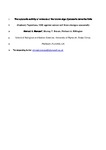The cytotoxic activity of extracts of the brown alga Cystoseira tamariscifolia (Hudson) Papenfuss, against cancer cell lines changes seasonally
| dc.contributor.author | Mansur, AA | |
| dc.contributor.author | Brown, MT | |
| dc.contributor.author | Billington, RA | |
| dc.date.accessioned | 2020-02-04T20:07:43Z | |
| dc.date.issued | 2020-08 | |
| dc.identifier.issn | 0921-8971 | |
| dc.identifier.issn | 1573-5176 | |
| dc.identifier.uri | http://hdl.handle.net/10026.1/15358 | |
| dc.description.abstract |
Brown seaweeds have been highlighted for their abundant production of bioactive substances that may provide novel drugs or drug scaffolds for a range of diseases, particularly cancer. Indeed, a number of promising compounds that can modulate growth arrest or apoptosis have already been isolated. As previous work has highlighted seasonal differences in concentrations of secondary metabolites, this study aimed to evaluate seasonal variation in the cytotoxic anticancer activity of Cystoseira tamariscifolia extracts. Primary and secondary metabolites were measured using colourimetric techniques and extracts were exposed to human leukaemia, HL60 and THP-1, and human prostate cancer PC3 cell lines in vitro, and cell viability was measured using the 3-(4,5-dimethylthiazol-2-yl)-2,5-diphenyl tetrazolium bromide (MTT) assay. The results confirm a large but inconsistent seasonal variation in the concentrations of biomolecules, although, generally, levels were higher in spring and summer. IC50 values for cytotoxicity also showed variability both seasonally and with extraction protocol, but again, this was inconsistent. These data suggest that when collecting brown algae in order to isolate novel bioactive compounds, repeated sampling across annual or biotic cycles of the seaweed and the use of multiple solvent extraction methods could give a greater possibility of discovering bioactive lead compounds. | |
| dc.format.extent | 2419-2429 | |
| dc.language | en | |
| dc.language.iso | en | |
| dc.publisher | Springer Science and Business Media LLC | |
| dc.subject | 3108 Plant Biology | |
| dc.subject | 31 Biological Sciences | |
| dc.subject | Urologic Diseases | |
| dc.subject | Prostate Cancer | |
| dc.subject | Cancer | |
| dc.subject | Cancer | |
| dc.title | The cytotoxic activity of extracts of the brown alga Cystoseira tamariscifolia (Hudson) Papenfuss, against cancer cell lines changes seasonally | |
| dc.type | journal-article | |
| dc.type | Journal Article | |
| plymouth.issue | 4 | |
| plymouth.volume | 32 | |
| plymouth.publication-status | Published | |
| plymouth.journal | Journal of Applied Phycology | |
| dc.identifier.doi | 10.1007/s10811-019-02016-z | |
| plymouth.organisational-group | /Plymouth | |
| plymouth.organisational-group | /Plymouth/Faculty of Science and Engineering | |
| plymouth.organisational-group | /Plymouth/Faculty of Science and Engineering/School of Biological and Marine Sciences | |
| plymouth.organisational-group | /Plymouth/REF 2021 Researchers by UoA | |
| plymouth.organisational-group | /Plymouth/REF 2021 Researchers by UoA/UoA03 Allied Health Professions, Dentistry, Nursing and Pharmacy | |
| plymouth.organisational-group | /Plymouth/REF 2021 Researchers by UoA/UoA06 Agriculture, Veterinary and Food Science | |
| plymouth.organisational-group | /Plymouth/Research Groups | |
| plymouth.organisational-group | /Plymouth/Research Groups/Marine Institute | |
| plymouth.organisational-group | /Plymouth/Users by role | |
| plymouth.organisational-group | /Plymouth/Users by role/Academics | |
| dcterms.dateAccepted | 2019-12-05 | |
| dc.rights.embargodate | 2021-1-6 | |
| dc.identifier.eissn | 1573-5176 | |
| dc.rights.embargoperiod | Not known | |
| rioxxterms.versionofrecord | 10.1007/s10811-019-02016-z | |
| rioxxterms.licenseref.uri | http://www.rioxx.net/licenses/all-rights-reserved | |
| rioxxterms.type | Journal Article/Review |


